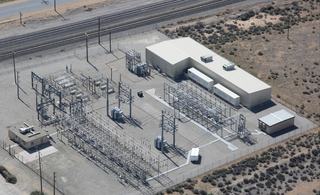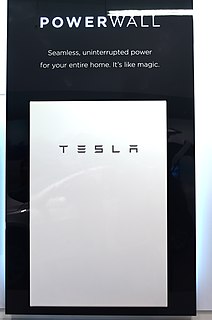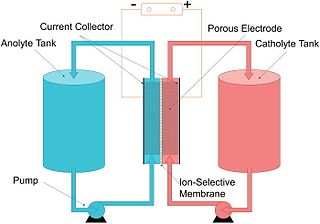 W
WGrid energy storage is a collection of methods used for energy storage on a large scale within an electrical power grid. Electrical energy is stored during times when electricity is plentiful and inexpensive or when demand is low, and later returned to the grid when demand is high, and electricity prices tend to be higher.
 W
WA123 Systems, LLC, a subsidiary of the Chinese Wanxiang Group Holdings, is a developer and manufacturer of lithium iron phosphate batteries and energy storage systems.
 W
WBeacon Power is an American limited liability company and wholly owned subsidiary of RGA Investments LLC specializing in flywheel-based energy storage headquartered in Tyngsboro, Massachusetts. Beacon designs and develops products aimed at utility frequency regulation for power grid operations.
 W
WMolten-salt batteries are a class of battery that uses molten salts as an electrolyte and offers both a high energy density and a high power density. Traditional non-rechargeable thermal batteries can be stored in their solid state at room temperature for long periods of time before being activated by heating. Rechargeable liquid-metal batteries are used for industrial power backup, special electric vehicles and for grid energy storage, to balance out intermittent renewable power sources such as solar panels and wind turbines.
 W
WThe Tehachapi Energy Storage Project (TSP) is a lithium-ion battery-based grid energy storage system at the Monolith Substation of Southern California Edison in Tehachapi, California. At the time of commissioning in 2014, it was the largest lithium-ion battery system operating in North America and one of the largest in the world. The TSP system can supply 32 megawatt-hours of energy, at a maximum rate of 8 megawatts. This is sufficient to power between 1,600 and 2,400 homes for four hours. TSP is considered to be a modern-day energy storage pioneer with significant accomplishments that have proven the viability of utility-scale energy storage using lithium-ion technology. While originally envisioned as a research and development project, TSP continues operation today as a distribution-level resource for Southern California Edison.
 W
WThe Powerwall and Powerpack are rechargeable lithium-ion battery stationary energy storage products manufactured by Tesla, Inc. The Powerwall is intended to be used for home energy storage and stores electricity for solar self-consumption, time of use load shifting, backup power, and off-the-grid use. The larger Powerpack is intended for commercial or electric utility grid use and can be used for peak shaving, load shifting, backup power, demand response, microgrids, renewable power integration, frequency regulation, and voltage control.
 W
WUniEnergy Technologies (UET) is a U.S. vanadium redox flow battery manufacturer in Mukilteo, Washington, which manufactures megawatt-scale energy storage systems for utility, commercial and industrial customers. The company was founded in 2012 by Dr. Gary Yang and Dr. Liyu Li to commercialize a new Vanadium electrolyte formulation the pair had developed while working at PNNL. The new formulation, a mixed-acid solution, was patented by PNNL and the patent was licensed to UET for commercialization. The mixed-acid vanadium electrolyte allows for a wider temperature range for operations, and double the energy density of the traditional vanadium electrolyte.
 W
WThe vanadium redox battery (VRB), also known as the vanadium flow battery (VFB) or vanadium redox flow battery (VRFB), is a type of rechargeable flow battery that employs vanadium ions in different oxidation states to store chemical potential energy. The vanadium redox battery exploits the ability of vanadium to exist in solution in four different oxidation states, and uses this property to make a battery that has just one electroactive element instead of two. For several reasons, including their relative bulkiness, most vanadium batteries are currently used for grid energy storage, i.e., attached to power plants or electrical grids.